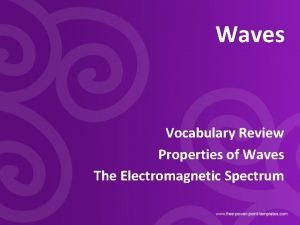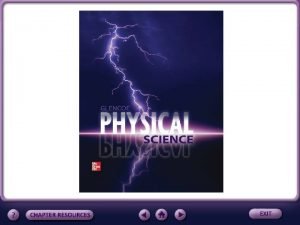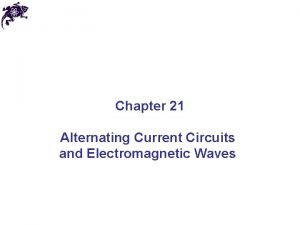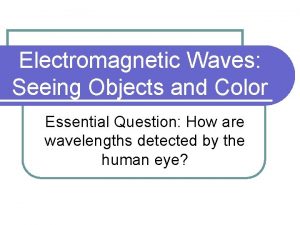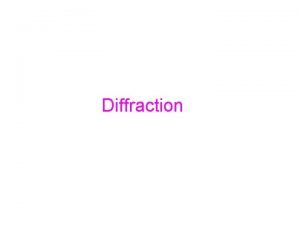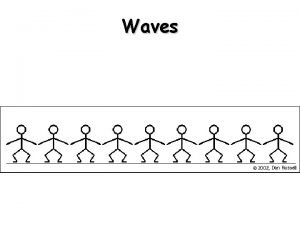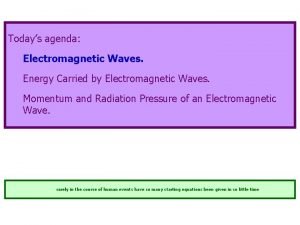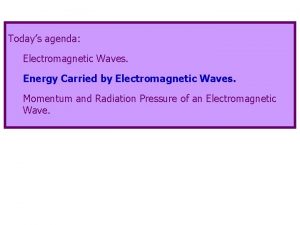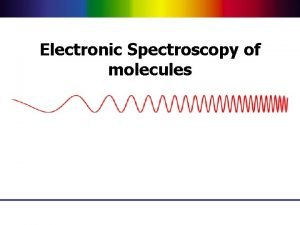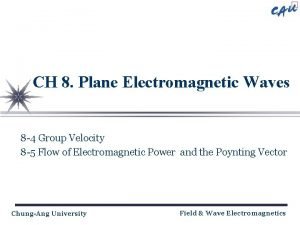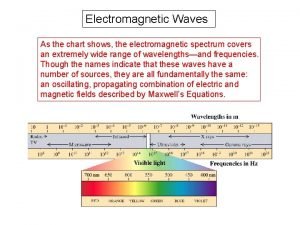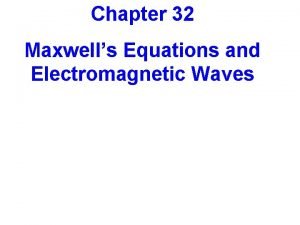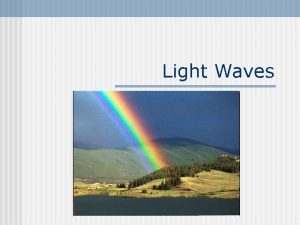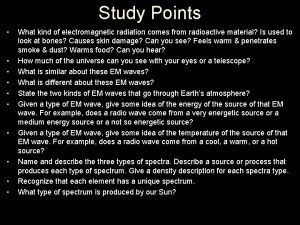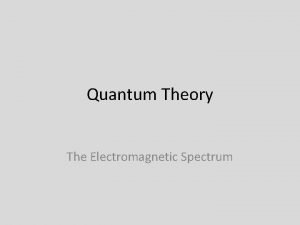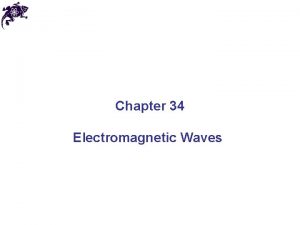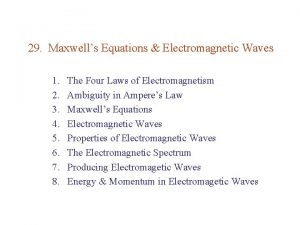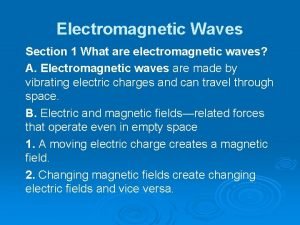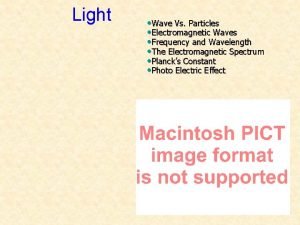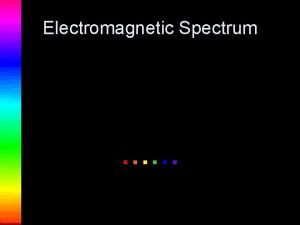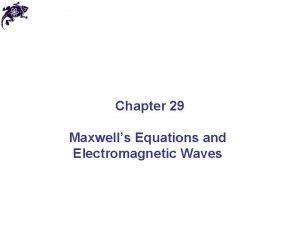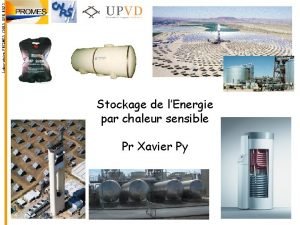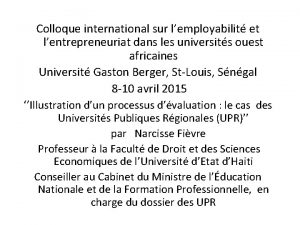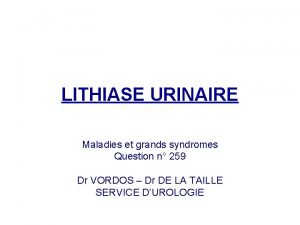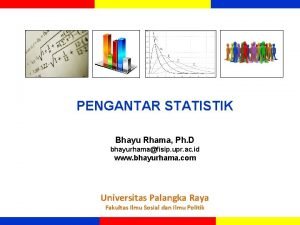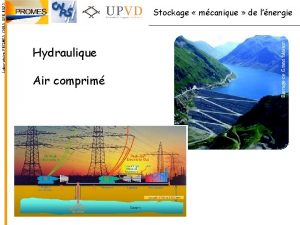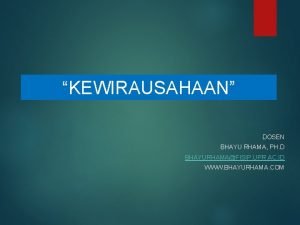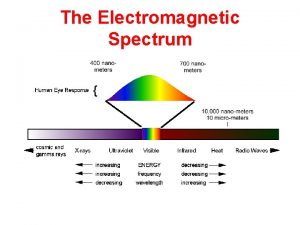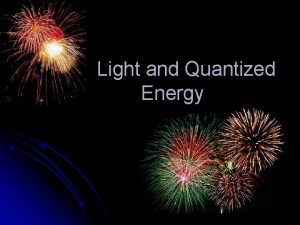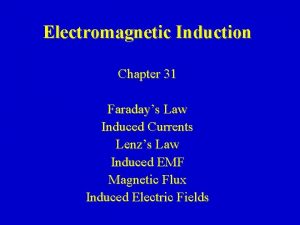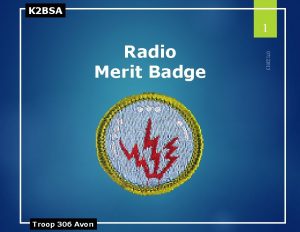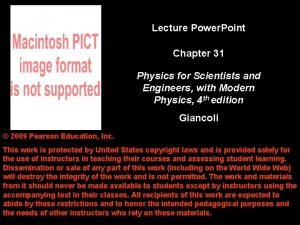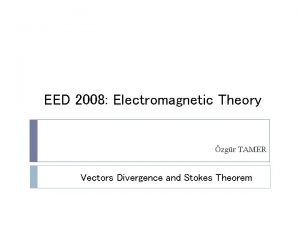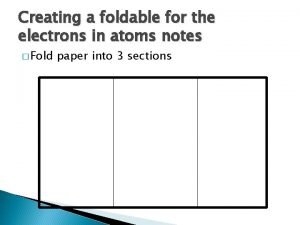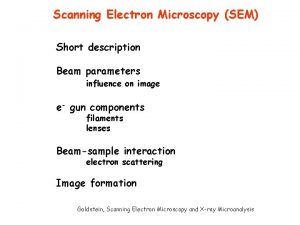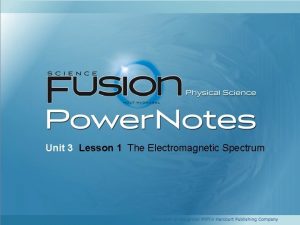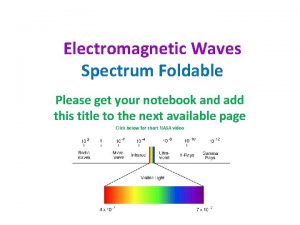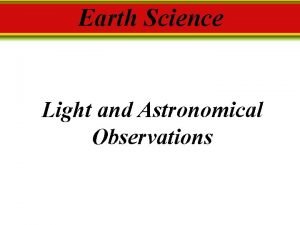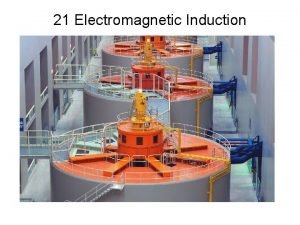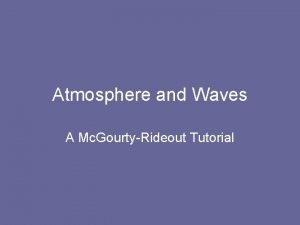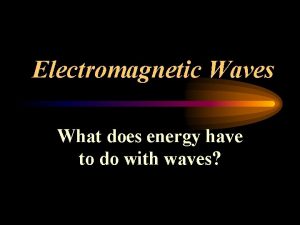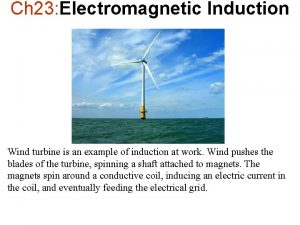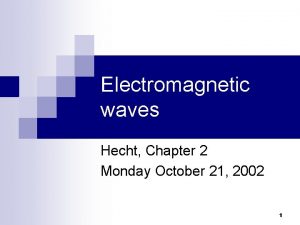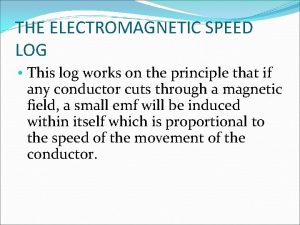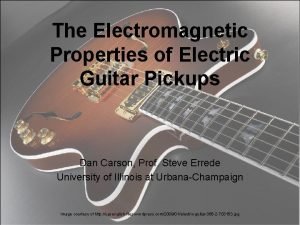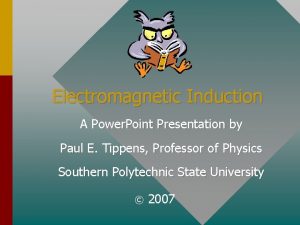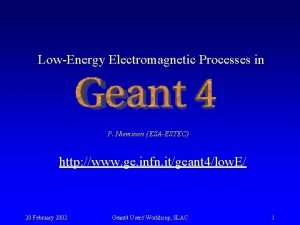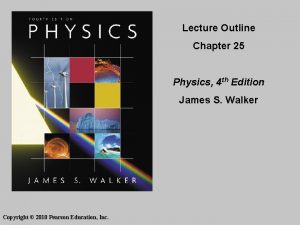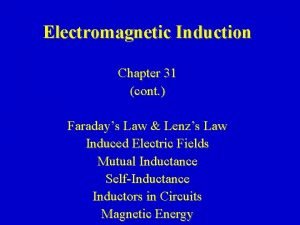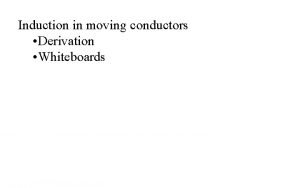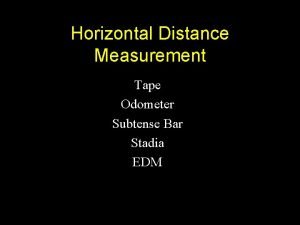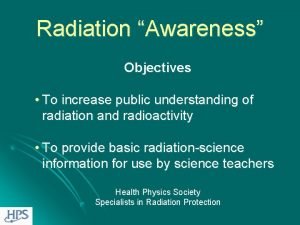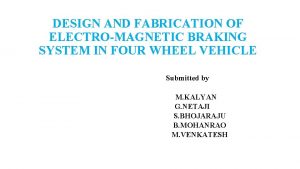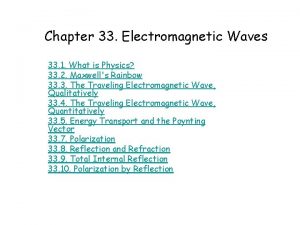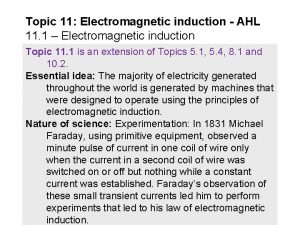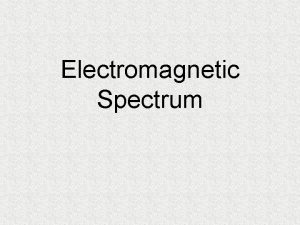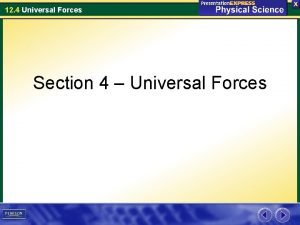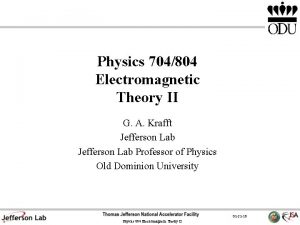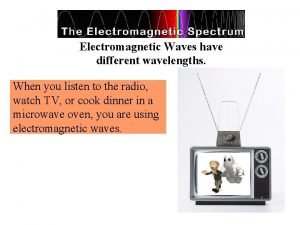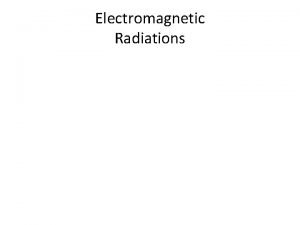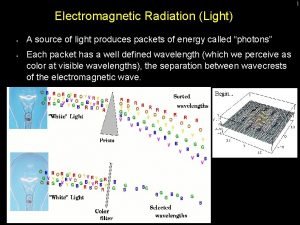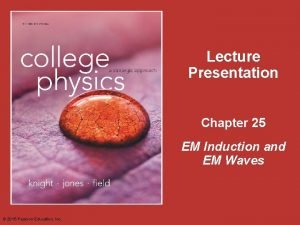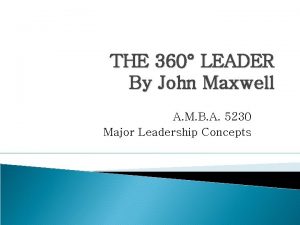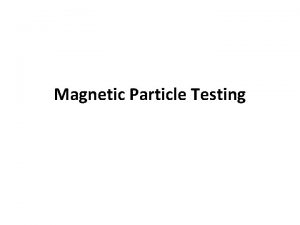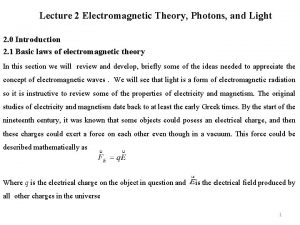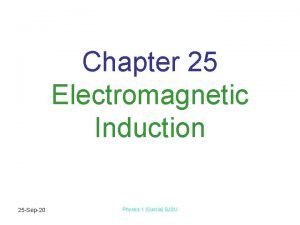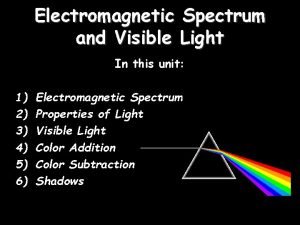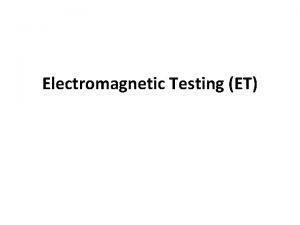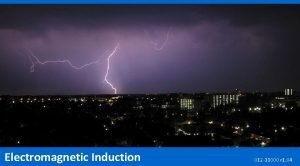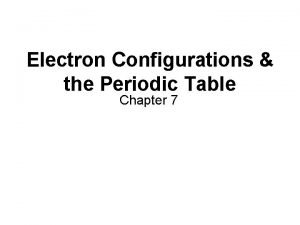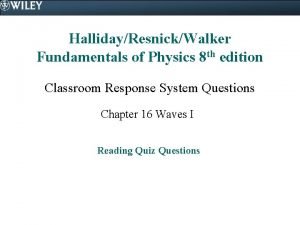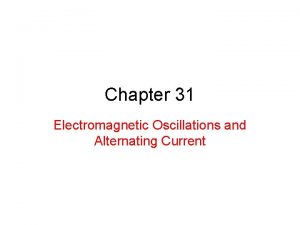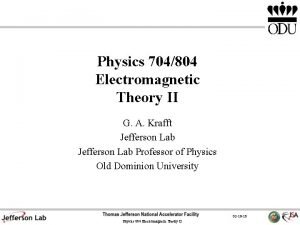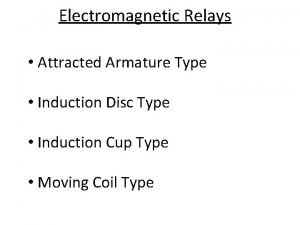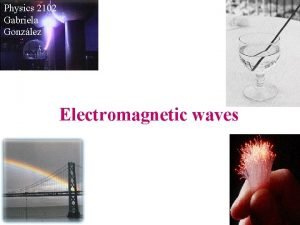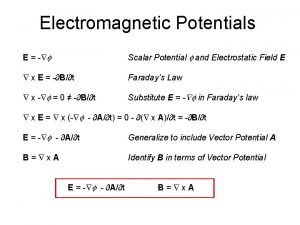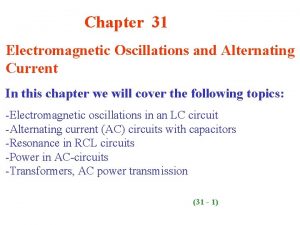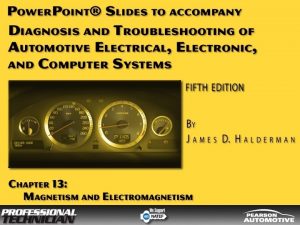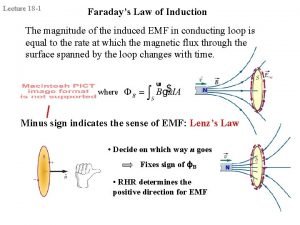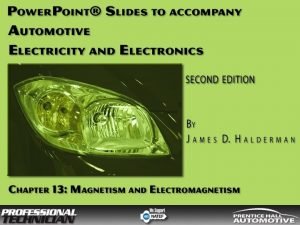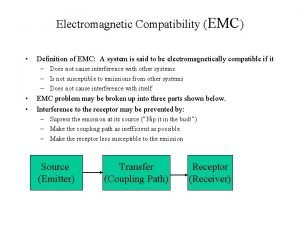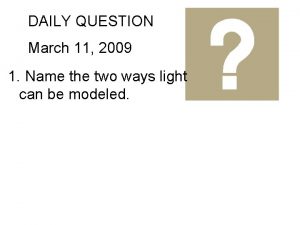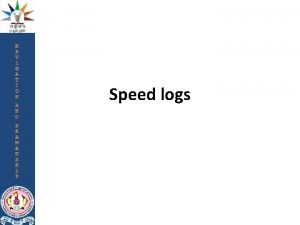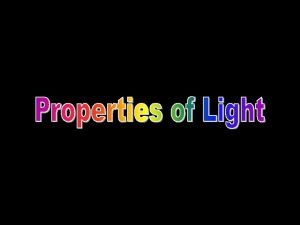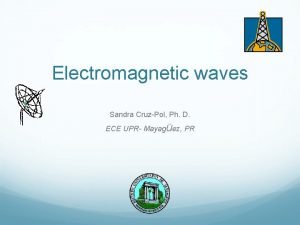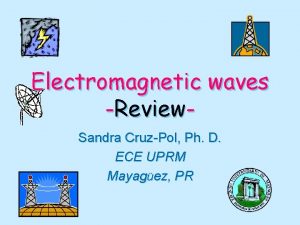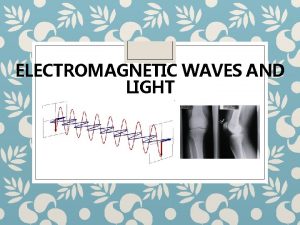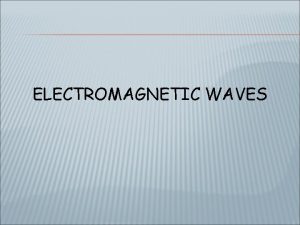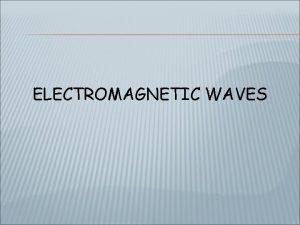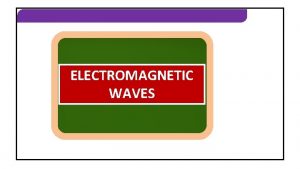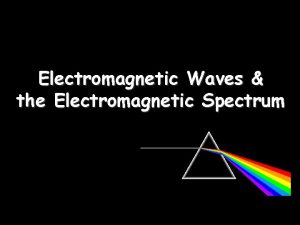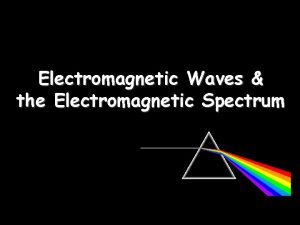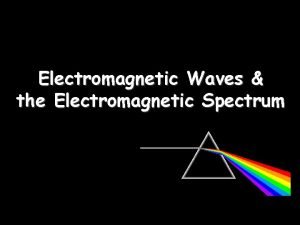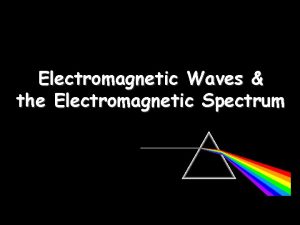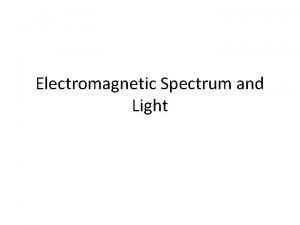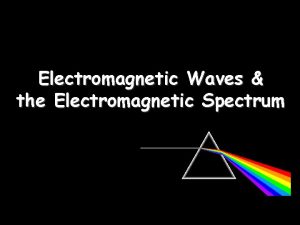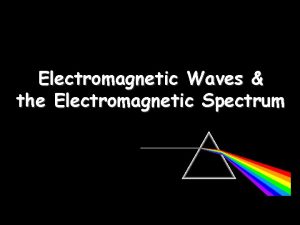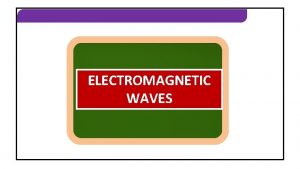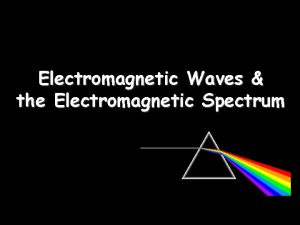Electromagnetic waves Sandra CruzPol Ph D ECE UPR
















































































































- Slides: 112

Electromagnetic waves Sandra Cruz-Pol, Ph. D. ECE UPR- Mayagüez, PR

Outline I. Faraday’s Law & Origin of Electromagnetics II. Transformer and Motional EMF III. Displacement Current & Maxwell Equations IV. Wave Incidence (normal, oblique) I. Lossy materials II. Multiple layers

Electricity => Magnetism Ø In 1820 Oersted discovered that a steady current produces a magnetic field while teaching a physics class. This is what Oersted discovered accidentally: Cruz-Pol, Electromagnetics UPRM

Would magnetism would produce electricity? Eleven(11) years later, and at the same time, (Mike) Faraday in London & (Joe) Henry in New York discovered that a time -varying magnetic field would produce an electric voltage! Cruz-Pol, Electromagnetics UPRM

Len’s Law = (-) If N=1 (1 loop) The time change can refer to B or S Cruz-Pol, Electromagnetics UPRM

Electromagnetics was born! This is Faraday’s Law the principle of motors, hydro-electric generators and transformers operation. Cruz-Pol, Electromagnetics UPRM

Faraday’s Law For N=1 and B=0 Cruz-Pol, Electromagnetics UPRM

Maxwell noticed something was missing… And added Jd, the displacement current S 1 I L S 2 At low frequencies J>>Jd, but at radio frequencies both Cruz-Pol, Electromagnetics UPRM terms are comparable in magnitude.

Cruz-Pol, Electromagnetics UPRM

Electromagnetic Spectrum Cruz-Pol, Electromagnetics UPRM

Uniform plane em wave approximation Cruz-Pol, Electromagnetics UPRM

Maxwell Equations in General Form Differential form Integral Form Gauss’s Law for E field. Gauss’s Law for H field. Nonexistence of monopole Faraday’s Law Ampere’s Circuit Law Cruz-Pol, Electromagnetics UPRM

Would magnetism would produce electricity? Eleven years later, and at the same time, Mike Faraday in London and Joe Henry in New York discovered that a time -varying magnetic field would produce an electric current! Cruz-Pol, Electromagnetics UPRM

Electromagnetics was born! This is the principle of motors, hydro-electric generators and transformers operation. This is what Oersted discovered accidentally: *Mention some examples of em waves Cruz-Pol, Electromagnetics UPRM

Special case Consider the case of a lossless medium with no charges, i. e. . The wave equation can be derived from Maxwell equations as What is the solution for this differential equation? The equation of a wave! Cruz-Pol, Electromagnetics UPRM

Phasors for harmonic fields Working with harmonic fields is easier, but requires knowledge of phasor. Ø The phasor is multiplied by the time factor, ejwt, and taken the real part. Cruz-Pol, Electromagnetics UPRM

Maxwell Equations for Harmonic fields Differential form* Gauss’s Law for E field. Gauss’s Law for H field. No monopole Faraday’s Law Ampere’s Circuit Law Cruz-Pol, Electromagnetics UPRM * (substituting and )

A wave Start taking the curl of Faraday’s law Then apply the vectorial identity And you’re left with Cruz-Pol, Electromagnetics UPRM

A Wave Let’s look at a special case for simplicity without loosing generality: • The electric field has only an xcomponent • The field travels in z direction Then we have Cruz-Pol, Electromagnetics UPRM

To change back to time domain From phasor …to time domain Cruz-Pol, Electromagnetics UPRM

Several Cases of Media 1. Free space 2. Lossless dielectric 3. Low-loss 4. Lossy dielectric 5. Good Conductor Permitivity: eo=8. 854 x 10 -12[ F/m] Permeability: mo= 4 p x 10 -7 [H/m] Cruz-Pol, Electromagnetics UPRM

1. Free space There are no losses, e. g. Let’s define The phase of the wave The angular frequency Phase constant The phase velocity of the wave The period and wavelength How does it moves? Cruz-Pol, Electromagnetics UPRM

3. Lossy Dielectrics (General Case) In general, we had From this we obtain So , for a known material and frequency, we can find g=a+jb Cruz-Pol, Electromagnetics UPRM

Any medium a Summary Lossless medium (s=0) 0 Low-loss medium (e”/e’<. 01) Good conductor (e”/e’>100) Units [Np/m] b [rad/m] h [ohm] uc w/b l 2 p/b=up/f **In free space; Cruz-Pol, Electromagnetics UPRM [m/s] [m] eo =8. 85 10 -12 F/m mo=4 p 10 -7 H/m ho=120 p W

Cruz-Pol, Electromagnetics UPRM

(Relative) Complex Permittivity For lossless media, The wavenumber, k, is equal to The phase constant. This is not so inside waveguides. Cruz-Pol, Electromagnetics UPRM

Cruz-Pol, Electromagnetics UPRM

Intrinsic Impedance, h If we divide E by H, we get units of ohms and the definition of the intrinsic impedance of a medium at a given frequency. *Not in-phase for a lossy medium Cruz-Pol, Electromagnetics UPRM

Note… E and H are perpendicular to one another Travel is perpendicular to the direction of propagation The amplitude is related to the impedance And so is the phase H lags E Cruz-Pol, Electromagnetics UPRM

Loss Tangent If we divide the conduction current by the displacement current Cruz-Pol, Electromagnetics UPRM

Relation between tanq and ec Cruz-Pol, Electromagnetics UPRM

2. Lossless dielectric Substituting in the general equations: Cruz-Pol, Electromagnetics UPRM

Review: 1. Free Space Substituting in the general equations: Cruz-Pol, Electromagnetics UPRM

4. Good Conductors Substituting in the general equations: Is water a good conductor? ? ? Cruz-Pol, Electromagnetics UPRM

Skin depth, d Ø Is defined as the depth at which the electric amplitude is decreased to 37% Cruz-Pol, Electromagnetics UPRM

Skin depth Cruz-Pol, Electromagnetics UPRM

Short Cut … You can use Maxwell’s or use where k is the direction of propagation of the wave, i. e. , the direction in which the EM wave is traveling (a unitary vector). Cruz-Pol, Electromagnetics UPRM

Exercises: Wave Propagation in Lossless materials A wave in a nonmagnetic material is given by Find: (a) direction of wave propagation, (b) wavelength in the material (c) phase velocity (d) Relative permittivity of material (e) Electric field phasor Answer: +y, up= 2 x 108 m/s, 1. 26 m, 2. 25, Cruz-Pol, Electromagnetics UPRM

Exercises: Wave Propagation in Lossless materials A wave in a nonmagnetic material is given by Find: (a) direction of wave propagation, (b) wavelength in the material (c) phase velocity (d) Relative permittivity of material (e) Electric field phasor Answer: +y, up= 2 x 108 m/s, 1. 26 m, 2. 25, Cruz-Pol, Electromagnetics UPRM

Power in a wave A wave carries power and transmits it wherever it goes The power density per area carried by a wave is given by the Poynting vector. Cruz-Pol, Electromagnetics UPRM http: //www. hitechmv. com/

Poynting Vector Derivation… Total power across surface of volume Rate of change of stored energy in E or H Ohmic losses due to conduction current Which means that the total power coming out of a volume is either due to the electric or magnetic field energy variations or is lost as ohmic losses. Cruz-Pol, Electromagnetics UPRM

Power: Poynting Vector Waves carry energy and information Poynting says that the net power flowing out of a given volume is = to the decrease in time in energy stored minus the conduction losses. Represents the instantaneous power vector associated to the electromagnetic wave. Cruz-Pol, Electromagnetics UPRM

Time Average Power The Poynting vector averaged in time is For the general case wave: For general lossy media Cruz-Pol, Electromagnetics UPRM

Total Power in W The total power through a surface S is Note that the units now are in Watts Note that the dot product indicates that the surface area needs to be perpendicular to the Poynting vector so that all the power will go thru. (give example of receiver antenna) Cruz-Pol, Electromagnetics UPRM

Exercises: Power 1. At microwave frequencies, the power density considered safe for human exposure is 1 m. W/cm 2. A radar radiates a wave with an electric field amplitude E that decays with distance as E(R)=3000/R [V/m], where R is the distance in meters. What is the radius of the unsafe region? Answer: 34. 6 m 2. A 5 GHz wave traveling in a nonmagnetic medium with er=9 is characterized by Determine the direction of wave travel and the average power density carried by the wave Answer: Cruz-Pol, Electromagnetics UPRM

TEM wave x x z z y Transverse Electro. Magnetic = plane wave There are no fields parallel to the direction of propagation, only perpendicular (transverse). If have an electric field Ex(z) …then must have a corresponding magnetic field Hx(z) The direction of propagation is Cruz-Pol, Electromagnetics UPRM

Polarization: Why do we care? ? Antenna applications – Antenna can only TX or RX a polarization it is designed to support. Straight wires, square waveguides, and similar rectangular systems support linear waves (polarized in one direction, often) Circular waveguides, helical or flat spiral antennas produce circular or elliptical waves. Remote Sensing and Radar Applications – Many targets will reflect or absorb EM waves differently for different polarizations. Using multiple polarizations can give different information and improve results. Rain attenuation effect. Absorption applications – Human body, for instance, will absorb waves with E oriented from head to toe better than side-to-side, esp. in grounded cases. Also, the frequency at which maximum absorption occurs is different for these two polarizations. This has ramifications in safety guidelines and studies. Cruz-Pol, Electromagnetics UPRM

Polarization of a wave IEEE Definition: The trace of the tip of the E -field vector as a function of time seen from behind. x x Basic types: z Vertical, Ex y y x z Horizontal, Ey y Cruz-Pol, Electromagnetics UPRM x y

Polarization In general, plane wave has 2 components; in x & y And y-component might be out of phase wrt to x-component, d is the phase difference between x and y. x Ex x y y Cruz-Pol, Electromagnetics UPRM Ey Front View

Cruz-Pol, Electromagnetics UPRM

Cruz-Pol, Electromagnetics UPRM

Several Cases Linear polarization: d=dy-dx =0 o or ± 180 on Circular polarization: dy-dx =± 90 o and ax=ay RHC is -90 o Elliptical polarization: dy-dx=± 90 o and ax≠ay, or d=≠ 0 o or ≠ 180 on even if ax=ay Unpolarized- (Natural radiation) Cruz-Pol, Electromagnetics UPRM

Linear polarization Front View d =0 x Exo y Eyo @z=0 in time domain Back View: x y Cruz-Pol, Electromagnetics UPRM

Circular polarization Ø Both components have same amplitude ax=ay, Ø d =d y-d x= -90 o = Right circular polarized (RCP) Ø d =+90 o = LCP x y Cruz-Pol, Electromagnetics UPRM

Elliptical polarization X and Y components have different amplitudes ax≠ay, and d =± 90 o Or d ≠± 90 o and Eox=Eoy, Cruz-Pol, Electromagnetics UPRM

Polarization example All light comes out Unpolarized radiation enters Nothing comes out this time. Polarizing glasses Cruz-Pol, Electromagnetics UPRM

Polarization Parameters Rotation angle, Ellipticity angle, tan of Axial ratio Cruz-Pol, Electromagnetics UPRM

Cruz-Pol, Electromagnetics UPRM

Polarization for em waves Cruz-Pol, Electromagnetics UPRM

Example Ø Determine the polarization state of a plane wave with electric field: a. b. c. d. Cruz-Pol, Electromagnetics UPRM a. Elliptic b. -90, RHEP c. LP<135 d. -90, RHCP

Cell phone & brain Computer model for Cell phone Radiation inside the Human Brain Cruz-Pol, Electromagnetics UPRM

Decibel Scale In many applications need comparison of two powers, a power ratio, e. g. reflected power, attenuated power, gain, … The decibel (d. B) scale is logarithmic Note that for voltages, the log is multiplied by 20 instead of 10. Cruz-Pol, Electromagnetics UPRM

Power Ratios G 10 x 100 4 2 1 0. 5 0. 25 0. 1 0. 001 G [d. B] 10 x d. B 20 d. B 6 d. B 3 d. B 0 d. B -3 d. B -6 d. B -10 d. B -30 d. B

Attenuation rate, A Represents the rate of decrease of the magnitude of Pave(z) as a function of propagation distance Assigned problems ch 2 1 -3, 5, 7, 9, 13, 16, 17, 24, 26, 28, 32, 36, 37, 40, 42, 43 Cruz-Pol, Electromagnetics UPRM

quiz Based on wave attenuation and reflection measurements conducted at 1 MHz, it was determined that the intrinsic impedance of a certain medium is and the skin depth is 2 m. Find: 1. the conductivity of the material 2. The wavelength in the medium 3. And phase velocity Cruz-Pol, Electromagnetics UPRM

Summary Any medium a Lossless medium (s=0) Low-loss medium (e”/e’<. 01) Good conductor (e”/e’>100) 0 Units [Np/m] b [rad/m] h [ohm] uc w/b l 2 p/b=up/f **In free space; Cruz-Pol, Electromagnetics UPRM [m/s] [m] eo =8. 85 10 -12 F/m mo=4 p 10 -7 H/m

Reflection and Transmission Wave incidence Wave arrives at an angle Snell’s Law and Critical angle Parallel or Perpendicular Brewster angle Cruz-Pol, Electromagnetics UPRM

Incidence Cruz-Pol, Electromagnetics UPRM

Reflection at Normal Incidence x Medium 1 Et e 1 , s 1 , m 1 Ei ak Hi Ht Incident wave y z=0 Reflected wave e 2, m 2, s 2 ak Transmitted wave Er akr Medium 2 Hr z

Now in terms of equations … Incident wave Ei Hi Incident wave ak

Reflected wave Er It’s traveling along –z axis akr Reflected wave Hr

The total fields • At medium 1 and medium 2 • Tangential components must be continuous at the interface

Normal Incidence • Reflection coefficient, r Note: • 1+ r = t • Transmission coefficient, t • Both are dimensionless and may be complex • 0≤|r|≤ 1

Normal Incidence Cruz-Pol, Electromagnetics UPRM

Oblique Incidence Ø Normal , an kiz Ø Plane of incidence Ø Angle of incidence Medium 2 : e 2, m 2 Medium 1 : e 1 , m 1 kix ki qi qr kr Cruz-Pol, Electromagnetics UPRM y z=0 qt kt

Expression for fields qi ki kiz kix

Tangential E must be Continuous From this we know that frequency is a property of the wave. So is color. So 700 nm is not always red!!

Snell Law Equating, we get or where, the index of refraction of a medium, ni , is defined as the ratio of the phase velocity in free space (c) to the phase velocity in the medium.

When going to a denser medium, the refraction is inward. Ulaby,

Critical angle, qc …All is reflected When qt =90 o, the refracted wave flows along the surface and no energy is transmitted into medium 2. The value of the angle of incidence corresponding to this is called critical angle, qc. If qi > qc, the incident wave is totally reflected.

Fiber optics Light can be guided with total reflections through thin dielectric rods made of glass or transparent plastic, known as optical fibers. The only power lost is due to reflections at the input and output ends and absorption by the fiber material (not perfect dielectric).

Optical fibers have cylindrical fiber core with index of refraction nf, surrounded by another cylinder of lower, nc < nf , called a cladding. [Figure from Ulaby, 1999] Use Snell and critical angle to derive: For total reflection: Acceptance angle

Perpendicular (H) or Parallel(V)

Parallel (V) polarization It’s defined as E is || to incidence plane x Medium 1 : e 1 , m 1 Er Et kr Ei qr qi ki qt y kt z z=0 Medium 2 : e 2, m 2

Equating for continuity, the tangent fields Which components are tangent to the interface between two surfaces? y and x At z = 0 (interface):

Reflection and Transmission Coefficients: Parallel (V) Incidence Reflection

Reflection and Transmission Coefficients: Perpendicular(H) Incidence

Property Normal Incidence Reflection coefficient Transmission coefficient Relation Power Reflectivity Power Transmissivity Snell’s Law: Cruz-Pol, Electromagnetics UPRM Perpendicular Parallel

Cruz-Pol, Electromagnetics UPRM

Cruz-Pol, Electromagnetics UPRM

Brewster angle, q. B Is defined as the incidence angle at which the reflection coefficient is 0 (total transmission). * q. B is known as the polarizing angle http: //www. amanogawa. com/archive/Oblique-2. html The Brewster angle does not exist for perpendicular Cruz-Pol, Electromagnetics UPRM polarization for nonmagnetic materials.

Reflection vs. Incidence angle. Reflection vs. incidence angle for different types of soil and parallel or perpendicular polarization. Cruz-Pol, Electromagnetics UPRM

Cruz-Pol, Electromagnetics UPRM

Two-Layer Composite Oblique Incidence Cruz-Pol, Electromagnetics UPRM

Multi-year ice seen by ICESat (2004 – 2008) and Ice. Bridge (2009– 2015) Relating the Age of Arctic Sea Ice to its Thickness, as Measured during NASA’s ICESat and Ice. Bridge Campaigns 2016 Mark A. Tschudi , Julienne C. Stroeve J. Scott Stewart Cruz-Pol, Electromagnetics UPRM

Trajectory Forecasts Based on Numerical Ocean Circulation Models and Satellite Observations: A Rapid Response to Deepwater Horizon Oil Spill -2010 By: Yonggang Liu University of South Florida A nowcast/forecast system was implemented immediately upon spill onset, by marshaling numerical model and satellite remote sensing. Surface oil locations inferred from satellite imagery were used to initialize the positions of the virtual particles in an ensemble of trajectory models, and the particles were tracked using forecast surface currents, with new particles added to simulate the continual release of oil from the well. Cruz-Pol, Electromagnetics UPRM

Cruz-Pol, Electromagnetics UPRM

Dielectric Slab: 2 layers Medium 1: Air Medium 2: layer of thickness d, low-loss (ice, oil, snow) Medium 3: Lossy Snell’s Law Phase matching condition at interphase: Cruz-Pol, Electromagnetics UPRM

Two ways to solve: 1. Propagation Matrix method 2. Multiple Reflection Method Cruz-Pol, Electromagnetics UPRM

Reflection Matrix For Medium 1: With: Cruz-Pol, Electromagnetics UPRM

Reflection Matrix For Medium 2: With: Cruz-Pol, Electromagnetics UPRM

Reflection Matrix For Medium 3: With: Cruz-Pol, Electromagnetics UPRM

Reflection Matrix At the top boundary, r 12, At the bottom boundary, r 23 For H polarization: For V polarization: Cruz-Pol, Electromagnetics UPRM

Reflection Matrix At the top boundary, r 12, At the bottom boundary, r 23 For H polarization: For V polarization: Cruz-Pol, Electromagnetics UPRM

Cruz-Pol, Electromagnetics UPRM

Multi-reflection Method Propagation factor: 1 2 d 3 Cruz-Pol, Electromagnetics UPRM

Cruz-Pol, Electromagnetics UPRM

Cont… for H Polarization Substituting the geometric series: And then Substituting Cruz-Pol, Electromagnetics UPRM and

Cruz-Pol, Electromagnetics UPRM

Cruz-Pol, Electromagnetics UPRM

Cruz-Pol, Electromagnetics UPRM

Antennas Now let’s review antenna theory Cruz-Pol, Electromagnetics UPRM
 Light is an electromagnetic wave true or false
Light is an electromagnetic wave true or false Mechanical vs electromagnetic waves
Mechanical vs electromagnetic waves What are the mechanical waves
What are the mechanical waves Mechanical waves and electromagnetic waves similarities
Mechanical waves and electromagnetic waves similarities Differences between mechanical and electromagnetic waves
Differences between mechanical and electromagnetic waves What do all waves transmit
What do all waves transmit Difference between electromagnetic and mechanical waves
Difference between electromagnetic and mechanical waves Difference between matter waves and electromagnetic waves
Difference between matter waves and electromagnetic waves Concept of electromagnetic waves
Concept of electromagnetic waves A health inspector is measuring the intensity of a sound
A health inspector is measuring the intensity of a sound Section 1 what are electromagnetic waves
Section 1 what are electromagnetic waves Alternating current circuits and electromagnetic waves
Alternating current circuits and electromagnetic waves Electromagnetic waves seeing objects and color
Electromagnetic waves seeing objects and color Diffraction ocean waves
Diffraction ocean waves Electromagnetic waves def
Electromagnetic waves def Energy carried by electromagnetic waves
Energy carried by electromagnetic waves Energy density of electromagnetic waves
Energy density of electromagnetic waves Electromagnetic spectrum
Electromagnetic spectrum Power of electromagnetic waves
Power of electromagnetic waves Electro magnetic chart
Electro magnetic chart Electromagnetic waves formulas
Electromagnetic waves formulas Radio waves, microwaves song lyrics
Radio waves, microwaves song lyrics Magnetic spectrum
Magnetic spectrum Electromagnetic waves characteristics
Electromagnetic waves characteristics What type of electromagnetic waves cause sunburns? *
What type of electromagnetic waves cause sunburns? * Conclusion of electromagnetic spectrum
Conclusion of electromagnetic spectrum Maxwell theory of electromagnetic waves
Maxwell theory of electromagnetic waves Electromagnetic powerpoint template
Electromagnetic powerpoint template Direction of electromagnetic waves
Direction of electromagnetic waves Section 1 what are electromagnetic waves
Section 1 what are electromagnetic waves Electromagnetic waves frequency
Electromagnetic waves frequency Electron spectrum
Electron spectrum Maxwell theory
Maxwell theory Upr
Upr Vis upr fvz
Vis upr fvz Upr
Upr Upr
Upr Logo fisip upr
Logo fisip upr Upr
Upr Absensi fisip upr
Absensi fisip upr Is a seismic wave mechanical or electromagnetic
Is a seismic wave mechanical or electromagnetic Sound waves longitudinal waves
Sound waves longitudinal waves Long waves and short waves
Long waves and short waves Compare and contrast p waves and s waves using venn diagram
Compare and contrast p waves and s waves using venn diagram Surface waves and body waves
Surface waves and body waves The difference between constructive and destructive waves
The difference between constructive and destructive waves Characteristics of a longitudinal wave
Characteristics of a longitudinal wave Electron spin
Electron spin Longest wavelength in electromagnetic spectrum
Longest wavelength in electromagnetic spectrum Types of radiation in the electromagnetic spectrum
Types of radiation in the electromagnetic spectrum Induced emf from magnetic flux
Induced emf from magnetic flux How radio waves carry information
How radio waves carry information Electromagnetic power formula
Electromagnetic power formula Curl in spherical coordinates
Curl in spherical coordinates Electromagnetic spectrum foldable
Electromagnetic spectrum foldable Sem
Sem Lesson 1: the electromagnetic spectrum
Lesson 1: the electromagnetic spectrum Electromagnetic spectrum foldable
Electromagnetic spectrum foldable Which telescope detects invisible electromagnetic radiation
Which telescope detects invisible electromagnetic radiation Motional emf units
Motional emf units What is the electromagnetic spectrum
What is the electromagnetic spectrum Facts about electromagnetic radiation
Facts about electromagnetic radiation Electromagnetic induction wind turbine
Electromagnetic induction wind turbine Poynting vector and intensity
Poynting vector and intensity Electromagnetic log
Electromagnetic log Electromagnetic spectrum pneumonic
Electromagnetic spectrum pneumonic Electromagnetic spectrum
Electromagnetic spectrum Electromagnetic pickups
Electromagnetic pickups Electromagnetic induction ppt
Electromagnetic induction ppt Electromagnetic spectrum
Electromagnetic spectrum Waves are produced by stars and galaxies
Waves are produced by stars and galaxies Momentum of electromagnetic field
Momentum of electromagnetic field Faraday's law of electromagnetic induction
Faraday's law of electromagnetic induction Electromagnetic spectrum foldable
Electromagnetic spectrum foldable Faraday's law derivation
Faraday's law derivation Subtense bar diagram
Subtense bar diagram Objectives
Objectives Design of electromagnetic braking system
Design of electromagnetic braking system Intensity in em wave
Intensity in em wave Electromagnetic induction
Electromagnetic induction Longest to shortest wavelength
Longest to shortest wavelength Universal forces
Universal forces Electromagnetic theory
Electromagnetic theory Electromagnetic spectrum with colors
Electromagnetic spectrum with colors The food
The food Light electromagnetic
Light electromagnetic Faraday's law of electromagnetic induction ppt
Faraday's law of electromagnetic induction ppt Properties of waves
Properties of waves Electromagnetic application
Electromagnetic application Electromagnetic force definition
Electromagnetic force definition Maxwell electromagnetic equation
Maxwell electromagnetic equation Circular magnetism
Circular magnetism Electromagnetic theory
Electromagnetic theory Electric generator electromagnetic induction
Electric generator electromagnetic induction Www.darvill.clara/emag
Www.darvill.clara/emag Electromagnetic testing (et)
Electromagnetic testing (et) Electromagnetic induction
Electromagnetic induction Electromagnetic periodic table
Electromagnetic periodic table Consider the three equations below.
Consider the three equations below. Electromagnetic oscillation pdf
Electromagnetic oscillation pdf Electromagnetic theory
Electromagnetic theory Wehnelt cylinder
Wehnelt cylinder Induction disk relay
Induction disk relay Intensity of wave
Intensity of wave What is scalar potential
What is scalar potential Electromagnetic oscillations and alternating current
Electromagnetic oscillations and alternating current Two technicians are discussing electromagnetic induction
Two technicians are discussing electromagnetic induction Faraday law
Faraday law Two technicians are discussing electromagnetic induction
Two technicians are discussing electromagnetic induction Emc definition
Emc definition Em spectrum mnemonic
Em spectrum mnemonic Electromagnetic speed log principle
Electromagnetic speed log principle Is light an electromagnetic wave
Is light an electromagnetic wave









